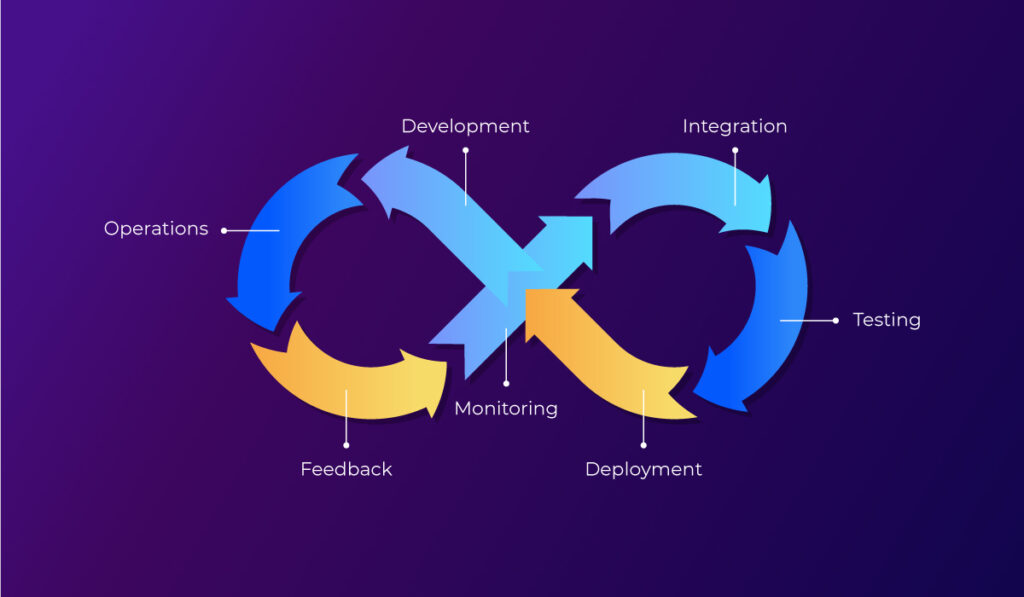The DevOps lifecycle has emerged as a game-changer in the rapidly changing world of software development, enabling seamless communication between development and operations teams to enable efficient and dependable product delivery. By fostering a culture of continuous improvement, automation, and close team alignment, DevOps enables businesses to quicken the development cycle and launch high-quality products quickly. The seven stages of the DevOps lifecycle will be covered in depth in this blog, along with examples from the real world to highlight the advantages and effects of implementing DevOps.

Phase 1: Planning and Requirements Gathering
The journey through the DevOps lifecycle begins with meticulous planning and gathering requirements. Teams from development and operations work together with stakeholders, product owners, and end users to comprehend the objectives of the project, specify its parameters, and pinpoint its precise requirements. Let’s use the following instance to demonstrate this stage:
Example: An e-commerce platform commissions a software development business to create a new mobile application. Discussions with the product owner, marketing team, and end users are held during the planning phase to determine the features, target market, and business goals of the application.
Phase 2: Continuous Integration (CI)
One of the pillars of the DevOps lifecycle is continuous integration. Development teams frequently integrate their code changes into a shared repository multiple times a day. Automated build and test processes ensure that code is continuously validated, preventing integration issues and reducing the risk of defects. Here’s an example to illustrate CI in action:
Example: A CI server automatically starts the build process after a developer pushes code changes to the main repository. To ensure that the new code fits neatly with the current codebase, the CI server runs automated tests. The development team is immediately informed of any problems or test failures that require solutions.
Phase 3: Continuous Delivery (CD)
Building on the foundation of Continuous Integration, Continuous Delivery automates the deployment process. CD ensures that the software is always in a deployable state, enabling teams to release changes to production quickly and reliably. Let’s see how Continuous Delivery works in practice:
Example: Every code update that passes the automated tests in the CI pipeline is automatically promoted to a staging environment in a continuous delivery environment. Before being released to production, the application undergoes extensive testing in the staging environment to lower the possibility of unanticipated problems in the live environment.
Phase 4: Automated Testing
The DevOps lifecycle includes automated testing as a key component. Early in the development process, automated tests such as unit tests, integration tests, and end-to-end tests assist in finding flaws. Let’s examine a case to illustrate the importance of automated testing:
Example: An example of this would be a software development team developing a web application for handling banking transactions. They offer a collection of automated tests that replicate several situations, including handling errors, processing valid transactions, and preserving data integrity. The program maintains a high level of functionality and stability thanks to automated testing.
Phase 5: Deployment Automation
Manual deployment procedures can be laborious and prone to mistakes. Consistent and dependable deployments are ensured via automation during the deployment process, which uses tools like Ansible, Chef, or Kubernetes. Let’s look at an illustration of deployment automation’s advantages:
Example: A development team might utilize tools like Kubernetes to deliver and manage containerized apps in a deployment automation scenario. The deployment process is automated, decreasing manual intervention and minimizing deployment failures. This enables the team to scale the application easily in response to demand.
Phase 6: Monitoring and Feedback Loop
Effective monitoring is crucial for gaining insights into the application’s performance and identifying potential issues. Monitoring tools like Prometheus and Grafana provide real-time visibility into various performance metrics, enabling quick responses to incidents. Here’s an example to demonstrate the importance of monitoring in DevOps:
Example: A web application experiences a sudden increase in traffic due to a marketing campaign. The monitoring tool detects the surge in requests, and the DevOps team is promptly notified. They quickly scale up the application servers to handle the increased load, ensuring a seamless user experience.
Phase 7: Continuous Improvement and Feedback
The DevOps lifecycle is based on the core notion of continuous improvement. Teams can reflect on existing processes, identify areas for improvement, and implement changes to increase efficiency and productivity through regular retrospectives. Let’s see an example of how continuous improvement drives positive changes:
Example: After a release, the DevOps team conducts a retrospective to discuss the development and deployment process. They identify bottlenecks in the pipeline and implement optimizations to streamline the process further. As a result, subsequent releases are faster and more reliable.
In Conclusion
The DevOps lifecycle provides a revolutionary approach to software development and delivery. Organizations can increase productivity, shorten time to market, and produce software products of higher quality by dismantling silos between development and operations teams, implementing automation, and promoting a culture of continuous improvement.
Teams may successfully negotiate the difficulties of contemporary software development and delivery by grasping each stage of the DevOps lifecycle and adopting its principles. This fosters creativity and provides end users with great value. Organizations that adopt this collaborative and iterative approach will prosper in the constantly changing world of technology as DevOps continues to develop.



